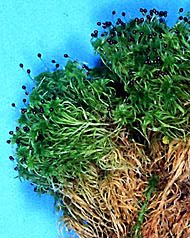

The Sphagnopsida are the peat mosses, the most important mosses today both ecologically and economically. For instance, peat-burning provides one-third of Ireland's energy requirements, and unlike fossil fuels, peat is a renewable resource when properly managed. In addition, peatlands are the habitat of commercial crops such as blueberries and cranberries.
Historically, peat mosses have been an important resource as well. In addition to serving as a large component of peat fuel, peat moss has absorptive and antiseptic properties, for which it has been used for everything from diapers to dressing wounds. These same qualities make peat important in horticulture as potting and as a soil additive.
All living species in this group belong to the genus Sphagnum, though fossils assigned to other genera are known from the Triassic and Permian.


